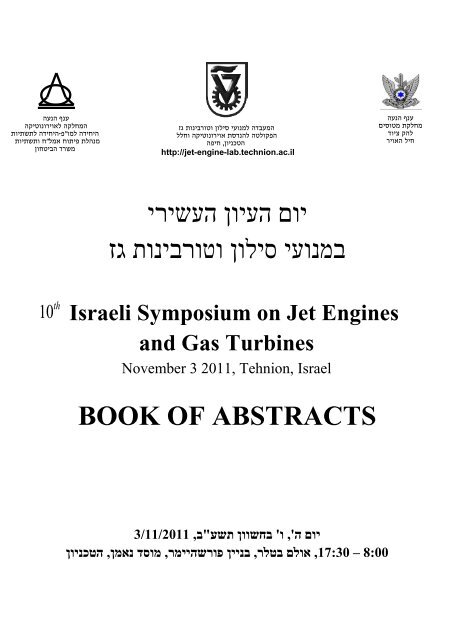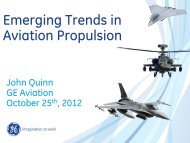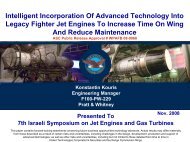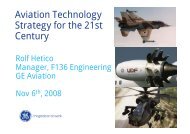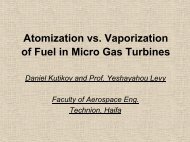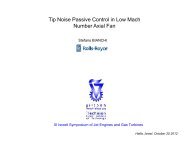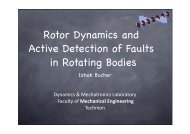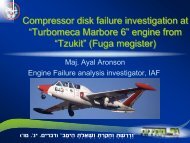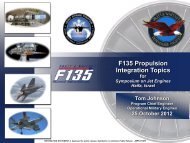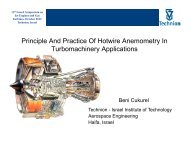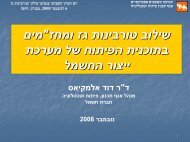× ×¢×©×ר ××× ××¢××× × ××× ××¢× ×¡×××× ×××ר××× ×ת ×× book of abstracts - Turbo & Jet ...
× ×¢×©×ר ××× ××¢××× × ××× ××¢× ×¡×××× ×××ר××× ×ת ×× book of abstracts - Turbo & Jet ...
× ×¢×©×ר ××× ××¢××× × ××× ××¢× ×¡×××× ×××ר××× ×ת ×× book of abstracts - Turbo & Jet ...
Create successful ePaper yourself
Turn your PDF publications into a flip-book with our unique Google optimized e-Paper software.
ענף הנעה<br />
מחלקת מטוסים<br />
להק ציוד<br />
חיל האויר<br />
המעבדה למנועי סילון וטורבינות גז<br />
הפקולטה להנדסת אוירונוטיקה וחלל<br />
הטכניון, חיפה<br />
http://jet-engine-lab.technion.ac.il<br />
ענף הנעה<br />
המחלקה לאוירונוטיקה<br />
היחידה למו"פ-הי חידה לתשתיות<br />
מנהלת פיתוח אמל"ח ותשתיות<br />
משרד הביטחון<br />
יום העיון העשירי<br />
במנועי סילון וטורבינות גז<br />
10 th Israeli Symposium on <strong>Jet</strong> Engines<br />
and Gas Turbines<br />
November 3 2011, Tehnion, Israel<br />
BOOK OF ABSTRACTS<br />
1/33/1133<br />
– ,33011 אולם<br />
יום ה', ו' בחשוון תשע"ב,<br />
בטלר, בניין פורשהיימר, מוסד נאמן, הטכניון<br />
0011
ענף הנעה<br />
מחלקת מטוסים<br />
להק ציוד<br />
חיל האויר<br />
המעבדה למנועי סילון וטורבינות גז<br />
הפקולטה להנדסת אוירונוטיקה וחלל<br />
הטכניון, חיפה<br />
http://jet-engine-lab.technion.ac.il<br />
ענף הנעה<br />
המחלקה לאוירונוטיקה<br />
היחידה למו"פ- היחידה לתשתיות<br />
מנהלת פיתוח אמל"ח ותשתיות<br />
משרד הביטחון<br />
יום העיון העשירי<br />
במנועי סילון וטורבינות גז<br />
10 th Israeli Symposium on <strong>Jet</strong> Engines<br />
and Gas Turbines<br />
November 3 2011, Tehnion, Israel<br />
BOOK OF ABSTRACTS<br />
יום ה', ו' בחשוון תשע"ב, 1/33/1133<br />
– 33011, אולם בטלר, בניין פורשהיימר, מוסד נאמן, הטכניון<br />
0011
תודות<br />
ACKNOWLEDGEMENTS<br />
ברצוננו להודות לגופים ולמוסדות שתמכו בקיום יום העיון:<br />
חיל האוויר<br />
מפא"ת<br />
טכניון<br />
– מכון טכנולוגי לישראל<br />
רפא"ל<br />
תודות לפרסום הכנס 0<br />
האגודה למדעי התעופה והחלל<br />
בישראל
ענף הנעה<br />
מחלקת מטוסים<br />
להק ציוד<br />
חיל האויר<br />
המעבדה למנועי סילון וטורבינות גז<br />
הפקולטה להנדסת אוירונוטיקה וחלל<br />
הטכניון, חיפה<br />
http://jet-engine-lab.technion.ac.il<br />
ענף הנעה<br />
המחלקה לאוירונוטיקה<br />
היחידה למו"פ- היחידה לתשתיות<br />
מנהלת פיתוח אמל"ח ותשתיות<br />
משרד הביטחון<br />
יום ה' ו' בחשוון תשע"ב<br />
יום העיון הישראלי העשירי במנועי סילון וטורבינות גז<br />
)10011-33011(, אולם בטלר, בניין פורשהיימר, מוסד נאמן )בניין<br />
(, 161 קרית הטכניון, הטכניון, חיפה<br />
1/33/1133<br />
10 th Israeli Symposium on <strong>Jet</strong> Engines and Gas Turbines<br />
Butler Auditorium, Forchheimer Building, Neaman Institute (Building #260), Technion, Haifa.<br />
CHAIRMAN: Pr<strong>of</strong>essor Yeshayahou Levy*<br />
(Registration) הרשמה 08:10 - 09:15<br />
09:15 - 09:30 Opening:<br />
Pr<strong>of</strong>essor Yeshayahou Levy, Chairman, Head,<br />
<strong>Turbo</strong> and <strong>Jet</strong> Engine Laboratory, Faculty <strong>of</strong><br />
Aerospace Engineering, Technion.<br />
Pr<strong>of</strong>essor Yoram Tambour , Dean, Faculty <strong>of</strong><br />
Aerospace Engineering, Technion.<br />
Ltc. Roni Gordana, Head, Propulsion Systems<br />
Branch, Aeronautical Division, MOD.<br />
Lt.Col. Shlomi Konforty, Head <strong>of</strong> Propulsion<br />
Branch, IAF.<br />
Session) (First מושב ראשון 9:30 - 12:40<br />
Session Chairman: Izhak H<strong>of</strong>mann (Itche), Edmatech<br />
1. Technology and Tools for Reduced Total Cost <strong>of</strong><br />
Ownership, Mr. Tom Maxwell, General Manager,<br />
Military Propulsion Engineering & Mr. Gene E.<br />
Wiggs, Consulting Engineer, GE Aviation, USA<br />
2. Proactive Single Engine Flight Safety Risk<br />
Management, Mr. David McDermott, Chief<br />
Engineer, F100, TF33, J52 Engine Programs, United<br />
Technologies / Pratt & Whitney, USA.<br />
refreshments) (Break and הפסקה וכיבוד קל 11:10-11:30<br />
3. Low NOx Flameless Combustion for <strong>Jet</strong> Engines<br />
and Gas turbines, Pr<strong>of</strong>. Yeshayahou Levy,<br />
Technion, Israel<br />
4. Correction <strong>of</strong> time dependent engine parameters<br />
for analysis <strong>of</strong> transient effects, Dr. Michael<br />
Lichtzinder, Bet Shemesh Engines Ltd.<br />
5. <strong>Turbo</strong>charging a commercial gas turbine,<br />
Dr. David Lior, R-<strong>Jet</strong> Engineering<br />
(Lunch) ארוחת צהריים 12:40 - 14:00<br />
Session) (Second מושב שני 14:00 - 17:15<br />
Session Chairman: Dr Valery Sherbaum, Technion<br />
<br />
Pr<strong>of</strong>essor Yeshayahou Levy, Trends in Engine<br />
Development, Research Activities in the <strong>Jet</strong> Engine<br />
Laboratory and Student Scholarship Ceremony.<br />
6. Oil Priming Problem in <strong>Jet</strong> Engines, Mr. Lev<br />
Dvoskin, Bet-Shemesh Engine Limited.<br />
7. System Integration <strong>of</strong> gas-turbine-driven electric<br />
generators in oil and gas production facilities in<br />
Siberia, Mr. Yossi Lev, Consulting Engineer, LSI –<br />
Lev Systems Integration Ltd.<br />
8. Student's Design Project: 250 HP Engine for<br />
Unmanned Helicopter with Reduced Infrared<br />
Signature, Jessica Yana,Yonatan Lobivikov & Akiva<br />
Marc Sharma (under the supervision <strong>of</strong> Dr. B. Glezer).<br />
refreshments) (Break and הפסקה וכיבוד קל 15:35 - 15:55<br />
9. <strong>Jet</strong> Engines' test cells – Considerations in selecting<br />
level <strong>of</strong> automation, Mr. Ze'ev Ben-Porath,<br />
MAGNUS Engineering and Maintenance LTd.<br />
10. Compressor failure in Marbore Engine, Eyal<br />
Aronson, IAF.<br />
11. Improvements in Exhaust gas temperature<br />
measurement <strong>of</strong> <strong>Jet</strong> Engine, Mr. Albert levy, Bet<br />
Shemesh Engines Ltd.<br />
12. Numerical Aspects <strong>of</strong> High Altitude Test Chamber<br />
for Engines, Dr. Savely Khosid, Dr. Uri Katz, Mr.<br />
Itzhak Greenberg and Dr. Amiram Leitner.<br />
(Closure) דברי סיכום 17:15 - 17:20<br />
* Pr<strong>of</strong>. Yeshayahou Levy:<br />
E-mail: levyy@aerodyne.technion.ac.il<br />
Tel: 04 8293807 Fax: 04 8121604 Mobile: 0547 355890.
Lecture #1<br />
Technology and Tools for Reduced Total Cost <strong>of</strong> Ownership<br />
Mr. Tom Maxwell,<br />
General Manager, Military Propulsion Engineering & Gene E. Wiggs, Consulting<br />
Engineer, GE Aviation, USA<br />
In today’s environment <strong>of</strong> leaner acquisition budgets and sustainment resources,<br />
reduced total life cycle costs are imperative to maintain readiness in the military<br />
world and pr<strong>of</strong>itability in the commercial world. This talk will explore the impact <strong>of</strong><br />
technologies that improve the affordability and availability <strong>of</strong> fielded and future<br />
aerospace propulsion systems by extending service life, ensuring flight safety,<br />
reducing sustainment costs, and ensuring mission readiness and capability.<br />
In particular, the status and state-<strong>of</strong>-the-art in probabilistic fracture mechanics for<br />
lifing and design will be highlighted along with the potential advantages and benefits<br />
these tools bring. Other technologies that will be discussed include the planned<br />
introduction <strong>of</strong> a new class <strong>of</strong> high temperature ceramic matrix composites (CMCs)<br />
capable <strong>of</strong> withstanding temperatures several hundred degrees higher than that <strong>of</strong><br />
current Ni-base alloys, approaches and methods for improved component efficiencies,<br />
advanced coatings for corrosion and harsh environment mitigation, and prognostics<br />
and health management (PHM). Finally, the status <strong>of</strong> GE’s demonstrator engine<br />
programs, AATE & and ADVENT, will be reviewed as they relate to developing and<br />
advancing these state-<strong>of</strong>-the-art technologies, tools, and methods.<br />
- 5 -
Lecture #2<br />
Proactive Single Engine Flight Safety Risk Management<br />
Mr. David McDermott<br />
Chief Engineer, F100, TF33, J52 Engine Programs<br />
United Technologies / Pratt & Whitney<br />
East Hartford, CT USA<br />
david.mcdermott@pw.utc.com<br />
This paper contains forward-looking statements concerning future business<br />
opportunities. Actual results may differ materially from those described as a result <strong>of</strong><br />
certain risks and uncertainties, including challenges in the design, development,<br />
production and support <strong>of</strong> advanced technologies; as well as other risks and<br />
uncertainties, including but not limited to those detailed from time to time in United<br />
Technologies Corporation's Securities and Exchange Commission filings.<br />
ABSTRACT<br />
Flight safety is a fundamental priority for a viable and successful aviation industry.<br />
There as been significant progress in reducing mishap rates since the beginnings <strong>of</strong><br />
the jet age <strong>of</strong> aviation. Much <strong>of</strong> this progress has been achieved through more robust<br />
engineering, manufacturing and the benefits <strong>of</strong> lessons learned. As design and<br />
manufacturing methods continue to improve there is an emerging trend that shows<br />
human factors – mistakes made by a person – are becoming a larger proportion <strong>of</strong><br />
today’s mishaps. This presentation reviews flight safety trends in the US Air Force<br />
with a specific focus on the F100 engine, a long standing front line fighter engine in<br />
F-15 and F-16 aircraft operating around the world. The F100 engine has achieved a<br />
world class single-engine safety record through a proactive flight safety program that<br />
benefits from an ingrained safety culture and strict processes focused on mishap<br />
prevention. The presentation will highlight the usefulness <strong>of</strong> quantitative safety risk<br />
assessment tools and active field monitoring to achieve a closed-loop process.<br />
Closing the loop in the management <strong>of</strong> safety concerns provides information to key<br />
decision makers who can then make proactive adjustments to risk management plans<br />
to avoid mishaps lurking from latent, unsafe conditions.<br />
- 6 -
Lecture # 3<br />
Low NOx Flameless Combustion for <strong>Jet</strong> Engines and Gas turbines<br />
Pr<strong>of</strong>. Yeshayahou Levy,<br />
Faculty <strong>of</strong> Aerospace Engineering, Technion, Israel<br />
levy@aerodyne.technion.ac.il<br />
New designs <strong>of</strong> gas turbines combustors and jet engines must exhibit low NOx<br />
emissions in order to comply with the new environmental regulations. NOx emission<br />
values have to be reduced by at least one order <strong>of</strong> magnitude, to about 20 ppm and<br />
below (parts per millions <strong>of</strong> the gases in the exhaust). Current low NOx designs still<br />
suffer from combustion instability, flashback and low dynamic range. The present<br />
study is aimed toward understanding the basics <strong>of</strong> the low NOx, flameless combustion<br />
technique. The flameless combustion is characterized by combustion stability at low<br />
equivalence (fuel) ratio (thus low NOx), uniform temperature distribution, low<br />
turbulence and noise, low visibility and the requirement for relative large volume.<br />
A high momentum central jet entrains gases from the surroundings <strong>of</strong> its nozzle,<br />
creating a large recirculation, recirculating combustion products to the vicinity <strong>of</strong> the<br />
air nozzle. Fuel is injected into the recirculated gases prior to their mixing with the<br />
fresh air. Whenever temperature <strong>of</strong> the mixed reactance (fuel + air + recirculated<br />
combustion products) exceeds the spontaneous ignition temperature and the<br />
equivalence ration will be above a certain minimum value (typically 0.3-0.5), stable<br />
combustion will occur.<br />
Flameless combustion study is performed using a generic combustor assembly. Its<br />
objective is to gain better understanding <strong>of</strong> the physics involved. A combined<br />
theoretical – experimental study is performed together with the IST University in<br />
Lisbon, where the Technion is responsible for the theoretical aspect and IST<br />
performed the experimental part.<br />
Different operational conditions were examined, that are relevant for gas turbines and<br />
jet engines. It was realized that it is difficult to achieve flameless conditions in<br />
practical systems unless heat extraction mechanism is incorporated from the<br />
combustion zone. Hence, the incorporation <strong>of</strong> heat transfer mechanism (fins) was also<br />
studied. Promising results were achieved, however yet, at the cost <strong>of</strong> larger weight<br />
and volume. During the presentation the basic <strong>of</strong> the combustion phenomena, the<br />
combustion system, the results and possible practical implementation will be<br />
described.<br />
- 7 -
Rotational Speed, kRPM<br />
Lecture # 4<br />
Correction <strong>of</strong> time dependent engine parameters for analysis <strong>of</strong><br />
transient effects<br />
Dr. Michael Lichtzinder, Bet Shemesh Engines Ltd.<br />
.<br />
קנה מידה של זמן לניתוח מנועי סילון במעטפת טיסה<br />
ד"ר מיכאל ליכטצינדר, מנועי בית שמש בע"מ<br />
בניתוח מנועי סילון במצב מתמיד state) (steady משמשים פרמטרים מתוקנים כמו מהירות סיבוב ,<br />
ספיקת אויר , ספיקת דלק , דחף וכו'. היתרון בשימוש בפרמטרים מתוקנים שהם בלתי תלויים בתנאי<br />
טיסה. התכונה הזאת מתקיימת בהנחה שנחירי המנוע )צנ"פ וטורבינה( חנוקים ו- פרמטרים לא משתנים<br />
משמעתית/ .<br />
בניגוד למצב מתמיד, במעבר פרמטרים מתוקנים )ולא מתוקנים( כפונקציה של זמן תלויים בתנאי טיסה<br />
כפי מוצג בציור.<br />
36<br />
Step-Function Response vs Time at Flight Envelope<br />
35.5<br />
35<br />
34.5<br />
34<br />
33.5<br />
33<br />
32.5<br />
Red Line: H= 0m; M= 0 delT=20 K<br />
Green Line: H= 4000m; M= 0 delT=20 K<br />
Blue Line: H= 5000m; M= 0.16 delT=20 K<br />
Magenta Line: H= 6000m; M= 0.3 delT=20 K<br />
Yellow Line: H= 6000y; M= 0.95 delT=20 K<br />
Black Line: H= 0m; M= 0.5 delT=20 K<br />
Tau=0.42...1.06s<br />
32<br />
0 1 2 3 4 5 6 7 8 9 10<br />
Time, sec<br />
<br />
ניתן להתגבר על התלות הזאת באמצעות הגדרת מושג "זמן מתוקן". פרמטרים מתוקנים כפונקציה של<br />
הזמן המתוקן בלתי תלויים בתנאי טיסה. היתרון של השלמת פרמטרים מתוקנים )רגילים( במשתנה זמן<br />
מתוקן בכך שבאמצעות אוסף הפרמטרים המתוקנים ניתן ליצור קשר בין דינאמיקת מנוע בקרקע ובטיסה .<br />
דוגמאות לשימוש בפרמטרים מתוקנים )כולל הזמן המתוקן( לפתרון בעיות דינאמיקת מנועי סילון:<br />
דינאמי מקורב פשוט שפועל בזמן אמת בניגוד ל" DECK-טבלאי" שבו קבעי<br />
זמן ומקדמי הינם מטריצות מסדר שלוש-ארבע .<br />
התנעה, בקר<br />
תיקון בקר של מנוע סילון בתנאי טיסה משתנים<br />
הגבלות בקרה.<br />
אמולציית תמרון מנוע סילון במצב מעבר בתנאי טיסה באמצעות ניסוי קרקעי.<br />
PID,<br />
((adaptive control:<br />
בניית DECK<br />
<br />
<br />
- 8 -
Lecture # 5<br />
<strong>Turbo</strong>charging a commercial gas turbine,<br />
Dr. David Lior, R-<strong>Jet</strong> Engineering<br />
<strong>Turbo</strong>charging piston engines increases their power and sometimes thermal<br />
efficiency. <strong>Turbo</strong>charging a gas turbine is difficult due to the integral design <strong>of</strong><br />
the combustor, also many modifications are required to the basic gas turbine<br />
ducts which are needed to convey the cold and hot flows betweenThe<br />
turbocharger and gas turbine’s compressor and turbine . This problem is even<br />
more complicated if a recuperator is integral within the gas turbine structure.<br />
Consequently all gas turbines are boosted by adding another compressor stage<br />
before the existing compressor and another turbine stage after the last turbine<br />
stage. Usually this modification entails a new shaft rotating concentric within<br />
the existing shaft—which becomes a major modification.<br />
Since most <strong>of</strong> small gasturbines are recuperated the task <strong>of</strong> manifolding the<br />
ducts to and out <strong>of</strong> the recuperator is even harder.<br />
An architecture <strong>of</strong> a new gasturbine the TG40 is presented which enables to<br />
add an automotive turbocharger with minor modification. The power is<br />
increased from 36kw to 120 kw electric, while the thermal efficiency is kept -<br />
about 35%. The electric output may be abstracted from any shaft chosen- but<br />
the recommended design is splitting the power between the 2 shafts. Thus -<br />
minor modifications are required for the original TG40.<br />
The design is flexible -different power levels up to 180kw may be achieved<br />
with the same hardware by varying the turbocharger speed .An automotive<br />
turbocharger is easily adapted with an inter-cooler.<br />
The thermodynamic cycle is presented including CHP performance.<br />
- 9 -
Lecture # 6<br />
Oil Priming Problem in <strong>Jet</strong> Engines,<br />
Lev Dvoskin, Bet-Shemesh Engine Limited<br />
- 10 -
Lecture # 7<br />
System Integration <strong>of</strong> gas-turbine-driven electric generators in oil<br />
and gas production facilities in Siberia<br />
Mr.Yossi Lev, Consulting Engineer, LSI – Lev Systems Integration Ltd.<br />
yossilev_lsi@bezeqint.net<br />
The projects to be described utilize associated petroleum gas, available as a by-product <strong>of</strong><br />
the crude oil produced in a Siberian oil field, to generate electricity by gas-turbine-driven<br />
generators. Previously the unused gas was mostly burned in flares.<br />
Turbine-generator packages are manufactured as almost standard units for the oil and gas<br />
industry, but still require customization for the local conditions. They include an<br />
industrial or aero-derivative gas-turbine engine, a reduction gearbox and a synchronous<br />
electrical generator inside an enclosure. Auxiliary equipment is provided to supply<br />
filtered air for combustion and ventilation, for lubricating oil cooling, and for command,<br />
control and safety. The differences between individual installations, that require specific<br />
design and integration, mainly result from the particular properties <strong>of</strong> the gas which is<br />
used as a fuel source and the conditions in which it is produced, from the interface<br />
between the turbo-generator and the electrical grid, and from the climatic conditions.<br />
In production facilities in oil fields, the mixture <strong>of</strong> crude oil, water and gas that comes<br />
from the wells is separated by mostly physical means. The gases that are separated are<br />
much richer in heavier hydrocarbons than the pipeline-quality natural gas, which is <strong>of</strong>ten<br />
used as the fuel for gas turbines, and they contain considerable amount <strong>of</strong> moisture. The<br />
pressure at which the gas is separated is too low for supply to the gas turbine, and must be<br />
increased.<br />
A gas compression system that combines flow, pressure and discharge-temperature<br />
closed-loop control was designed to overcome the problems <strong>of</strong> adapting the fuel gas to<br />
the limitation <strong>of</strong> gas turbine, and will be described, along with a brief survey <strong>of</strong> the<br />
alternatives.<br />
The motivations for the projects are both economical – to reduce the amount <strong>of</strong> energy<br />
purchased from the local utility company, and environmental – to reduce the flaring <strong>of</strong> the<br />
gas. Operation <strong>of</strong> the gas-turbine generators in parallel with the utility grid is desirable, as<br />
it allows immediate backup by the utility in cases <strong>of</strong> faults and scheduled stops, but adds<br />
some complication by requiring synchronization with the grid, and additional protection<br />
for events <strong>of</strong> shorts in the utility electricity lines. Solutions to those problems are quite<br />
standard, but there exists a non-trivial problem <strong>of</strong> immediately identifying the moment in<br />
which the generator is disconnected from the utility grid by some remote protective<br />
action. Failure to do so may result in destructive damage to the turbine engine. A solution,<br />
based on the identification <strong>of</strong> a change in the dynamics <strong>of</strong> the generating set, will be<br />
described.<br />
Some problems in the operation <strong>of</strong> the generating sets resulted from limitations in the oil<br />
cooling systems. The troubleshooting process and the unexpected reason for the problem<br />
will be described.<br />
Some parts <strong>of</strong> the generating sets had premature wear. These will be described, along<br />
with the attempts for their early detection using predictive maintenance methods.<br />
- 11 -
Lecture # 8<br />
Student's Design Project: 250 HP Engine for Unmanned Helicopter<br />
with Reduced Infrared Signature<br />
Jessica Yana, Yonatan Lobivikov & Akiva Marc Sharma, under the supervision <strong>of</strong> Dr. B.<br />
Glezer, Faculty <strong>of</strong> Aerospace Engineering, Technion<br />
This work describes the 250 HP gas turbine design for an unmanned helicopter with<br />
reduced infra- red signature. The design goal was to design a turbo shaft engine to power<br />
light unmanned helicopter that will be able to autonomously fly to the battle field, provide<br />
fighting troops with ammunition and carry wounded soldiers out <strong>of</strong> the danger zone to<br />
rear hospital. The design was conducted by a team <strong>of</strong> 3 persons specialized in<br />
Aerothermodynamics, Stress, Combustion & heat transfer and Design and advised by the<br />
Dr. Boris Glazer. The gas turbine design began by establishing main goals and objectives;<br />
as helicopter mission, cost, weight, and size. After setting some input parameters, the<br />
thermodynamic cycle was programmed using MATLAB. During the whole design<br />
process, the thermodynamic cycle was enriched and iterated. Then, the selection <strong>of</strong> the<br />
main components <strong>of</strong> the engine as well as their specifications was performed. The next<br />
step was to determine the components geometry through aerodynamic and stress<br />
considerations .Later on, the cooling and its impact on the thermodynamic cycle; stress<br />
and design have been implemented. Finally, detailed design was produced, and materials<br />
and manufacturing methods were selected. The designed engine was about 60 cm in<br />
length, and 50 cm in diameter. The weight <strong>of</strong> the engine was 165 kg, 51 <strong>of</strong> which was the<br />
recuperator. The fuel consumption <strong>of</strong> the engine for steady 250HP output deployment<br />
was 40kg/hour. Relatively to its similar engines that are in production, listed at the end <strong>of</strong><br />
this report, the engine design is very satisfying.<br />
The design restrains were very simple:<br />
Net output power: 250 HP<br />
Standard atmospheric conditions,<br />
Mach 0.2<br />
- 12 -
Lecture # 9<br />
<strong>Jet</strong> Engines' test cells – Considerations in selecting level <strong>of</strong><br />
automation<br />
Mr. Ze'ev Ben-Porath, MAGNUS Engineering and Maintenance LTd.<br />
Magnus engineering inc. specializes in the construction and maintenance <strong>of</strong><br />
computerized test cells for over 20 years. The generic s<strong>of</strong>tware package MCTC,<br />
developed by Magnus, is currently installed in more than 35 test cells worldwide,<br />
facilitating the testing <strong>of</strong> a variety <strong>of</strong> engines (over 60 engine types) for various<br />
applications (Military aircrafts, Civilian aviation, Helicopters, UAVs, tanks, buses<br />
etc.). Based on this experience, we identify 4 principal levels <strong>of</strong> test cell automation:<br />
1- No automation (independent displays with no central computing function).<br />
2- Centralized data acquisition (data acquired directly or from other subsystems,<br />
processed displayed and recorded in a central test cell computer).<br />
3- Test procedure tracking.<br />
4- Automated test execution.<br />
In general, a higher level <strong>of</strong> automation facilitates a more exact execution <strong>of</strong> the<br />
required test (from an engineering point <strong>of</strong> view) and a reduction in the cost <strong>of</strong> ongoing<br />
operation, at the price <strong>of</strong> a more expensive and more complex test cell.<br />
The main factors affecting the appropriate level <strong>of</strong> automation are:<br />
1 - Required accuracy.<br />
2 - Test procedure complexity (duration, number <strong>of</strong> steps, rate <strong>of</strong> change, number <strong>of</strong><br />
external devices controlled etc.).<br />
3 – Work load.<br />
4 – "Cost <strong>of</strong> error" (the cost <strong>of</strong> an engine problem not detected in the test cell or an<br />
untreated malfunction during the testing itself).<br />
Test cells for simple engines (e.g. diesel engine, mostly in the vehicle business), are<br />
commonly automated to the maximum level (4). This is due to economic<br />
considerations based on the fact that the test procedure is relatively simple and the<br />
workload is high.<br />
Most jet engine test cells, on the other hand, are currently at level 2 or 3. This can be<br />
attributed to the relatively high complexity <strong>of</strong> the test procedure (but not too complex<br />
to prevent manual operation) and the relatively low workload.<br />
Research using the playback and analysis utilities <strong>of</strong> MCTC has shown that the<br />
quality <strong>of</strong> testing <strong>of</strong> jet engines can be improved by upgrading the automation level <strong>of</strong><br />
- 13 -
the test cells. Additionally, savings <strong>of</strong> [testing] time and money [fuel] is also expected<br />
– making such a decision economically viable.<br />
In the lecture a simple method to estimate the expected savings (upper bound, lower<br />
bound, estimated actual saving) shall be described and demonstrated.<br />
It is our experience that for engines similar in complexity to the F100-PW-229 and<br />
F110-GE-100 engines:<br />
* Upgrading from level 2 to 3, a 30-50% saving in test time and fuel is expected.<br />
* Upgrading from level 3 to 4, a 5-10% saving in test time and fuel is expected.<br />
In the lecture the above issues shall be demonstrated by comparing actual run data<br />
from various test cells using MCTC analysis tools.<br />
Finally, a hypothetical upgrade <strong>of</strong> an existing test cell (running MCTC) from level 3<br />
to 4 is analyzed from an economic point <strong>of</strong> view.<br />
- 14 -
Lecture # 10<br />
Compressor failure in Marbore Engine,<br />
Eyal Aronson, IAF.<br />
"חקירת כשלון מנוע מרבורה בצוקית"<br />
רס"ן אייל ארונסון, ר"צ חקירות מנועים ( יא"א<br />
) 22 , חיל האוויר<br />
במסגרת אימון לקראת מטס אוירובטי בקורס טיס, במהלך ריצת המראה של מטוס<br />
צוקית Magister( )Fouga נשמע פיצוץ ןההמראה הופסקה.<br />
בבדיקת המטוס לאחר<br />
מכן נמצא כי מנוע שמאל מסוג<br />
MARBORE 6<br />
כשל, חלקים פרצו את המעטפת<br />
המנוע ופאנלים הועפו על המסולול. האירוע, שהינו בעל פוטנציאל בטיחותי מדרגה<br />
ראשונה, הסתיים ללא נפגעים.<br />
בחקירת המנוע, נמצא כי דיסק המדחס כשל, נשבר לשלושה חלקים עיקריים<br />
והוביל לפריצת מעטפת המנוע. חקירת הדיסק הראתה כי הכישלון נבע מעירור<br />
סדקים במנגנון שיתוך התעייפות FATIGUE( ,)CORROSION להם תרמו גם<br />
גומות שיתוך וחריגות במידות ייצור אשר הובילו לריכוז מאמצים ברדיוסי המעבר<br />
של השגמים בדיסק.<br />
בבדיקת יתר מנועי החיל נמצאו סדקים דומים בדיסקים<br />
הנראה אירועים נוספים.<br />
נוספים מה שמנע ככל<br />
- 15 -
Lecture # 11<br />
Improvements in Exhaust gas temperature measurement <strong>of</strong> <strong>Jet</strong><br />
Engine<br />
Mr. Albert levy, Bet Shemesh Engines Ltd.<br />
שיפור מדידת טמפרטורת גזי הפליטה במנוע סילון<br />
מרצה: דר. אלברט לוי, מנועי בית שמש בע"מ<br />
רקע<br />
גזי הפליטה ממנוע סילון הינם תוצרי בעירת הדלק בעודף אוויר ניכר ומתקבלים בטמפרטורה גבוהה,<br />
מ"צ, בתלות במהירות הסיבוב של המנוע ותנאי הטיסה.<br />
טמפרטורת גזי הפליטה מהווה מגבלת מנוע לתפעול ואינדיקציה למרווח הבטחון הקיים<br />
לעמידות הטורבינה , ושאר רכיבי החלק החם בתנאי התפעול באופן שוטף .<br />
דיוק המדידה מוגבל בהתאם לתכונות הפיזיקליות של המדיד ולהתקנה.<br />
T4/EGT<br />
555-0055<br />
כללי<br />
במסגרת ההרצאה יוצגו חלק מהגורמים לאי דיוק במדידת טמפרטורה של גזי הפליטה במנוע סילון<br />
והפעילות שבוצעה על מנת לבצע שיפור תכן של המדידים.<br />
צמד מתכות המגיב ביצירת<br />
הינו תרמוקפל סקירה<br />
ביישומים רבים אמצעי המדידה המשמש למדידת<br />
פוטנציאל מתח בהתאם לטמפרטורה אליה חשופה נקודת החיבור ביניהן.<br />
במסגרת הסקירה שבוצעה ביישום שנבדק, יוצגו מגבלות הדיוק התקניות של מדידת מסוג תרמוקפל וכן<br />
גורמים נוספים התורמים לאי הדיוק, וביניהם השפעת הולכה תרמית מממשק ההתקנה לגוף הנמדד, עומק<br />
ועוד.<br />
ההתקנה, מידת חשיפת המדיד, פילוג הטמפרטורה<br />
תוצג סקירה של אופן התקנת מדידים במנועים מסוגים שונים ובהתאם השיקולים בקביעת תצורת המדידה<br />
המשופרת ליישום הספציפי במנוע הסילון.<br />
–<br />
EGT<br />
(SPREAD)<br />
סיכום<br />
התקבלו לקחים לגבי שיפורי תכן נדרשים בהתקנת מדיד טמפרטורת גזי הפליטה במנוע סילון )וסוג<br />
,כמות, מיקום(<br />
אבי הטיפוס שנבדקו הראו שיפור בדיוק המדידה.<br />
- 16 -
Lecture # 12<br />
Numerical Aspects <strong>of</strong> High Altitude Test Chamber for Engines<br />
Dr. Savely Khosid, Dr. Uri Katz, Mr. Itzhak Greenberg and Dr. Amiram Leitner<br />
RAFAEL – Advanced Defense Systems, MANOR Division,<br />
<strong>Turbo</strong>-<strong>Jet</strong> Engine Department, Haifa, ISRAEL<br />
High altitude test facility serves rocket and turbojet engines development<br />
programs in Israel for more than 20 years. This facility provides large range <strong>of</strong><br />
parameters for altitude simulation: 50 ton <strong>of</strong> compressed air at 200 atm pressure are<br />
heated and then delivered through the ejector (~200 kg/s) and reduces the pressure in<br />
the test cell up to the level <strong>of</strong> 0.03-0.3 atm, using supersonic flows. More than 30m <strong>of</strong><br />
converging, diverging and cylindrical pipes are connected in order to provide a<br />
desired pressure field with shock waves at the necessary locations. The design <strong>of</strong> the<br />
facility was performed using basic relations for ejector and supersonic diffuser<br />
analysis. The working point was properly tuned and successfully achieved in a long<br />
series <strong>of</strong> experiments. However, the <strong>of</strong>f-design operation <strong>of</strong> the high altitude facility<br />
remained questionable, and optimum conditions for maximum duration <strong>of</strong><br />
experiments were unknown.<br />
Numerical simulation <strong>of</strong> the complicated physical phenomena with modern<br />
tools allows understanding <strong>of</strong> the fluid dynamics inside the facility and helps us to<br />
optimize it. In our presentation we describe CFD analysis that has been conducted for<br />
the whole experimental installation. Clear picture <strong>of</strong> flow behavior and shock waves<br />
location was observed. Non-linear nature <strong>of</strong> the flow phenomena was demonstrated.<br />
Good comparison with large-scale experiments was achieved, and optimization <strong>of</strong><br />
future experiments was proposed.<br />
- 17 -
- 18 -
- 19 -
- 20 -


